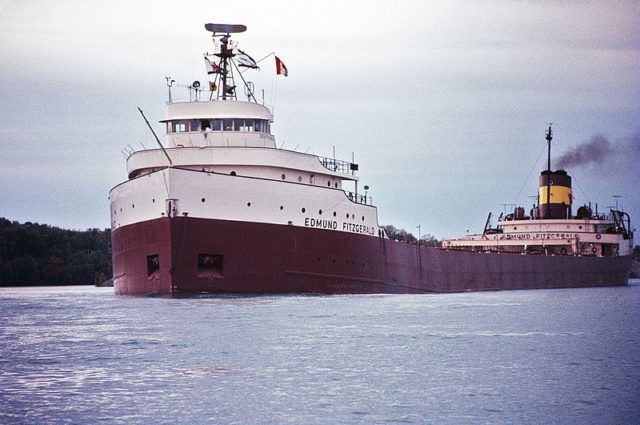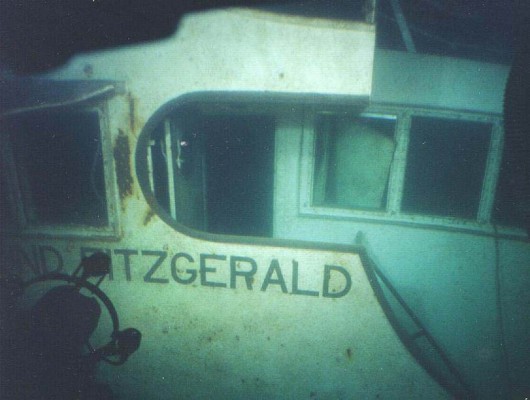The final voyage of Edmund Fitzgerald, that commenced on November 9th, 1917, and its subsequent disappearance, are extremely mysterious. The event has been subject to a number of speculations, some more wild then others. Captained by Ernest M. McSorley, Fitzgerald left the Burlington Northern Railroad Dock 1 in Superior Wisconsin.
The ship was carrying almost 27,000 tons of taconite pellet: processed iron ore that had been heated and rolled in the size of small marbles. Soon after departing Lake Superior at around 2:30 pm, Fitzgerald was joined by another ship, Arthur M. Anderson, which had left Two harbors, Minnesota, and was captained by Bernie Cooper.
Captain Bernie Cooper provided the bulk of first-hand account of the last moments of the Fitzgerald as his ship crew was constantly in contact with the doomed ship through the radio. Since Fitzgerald was the fastest of the two vessels, it was in the lead and was at least 10 to 15 miles ahead of Anderson.

Captain Cooper of the Anderson and Captain McSorley of the Fitzgerald both agreed to take the northern course across Superior under the protection of highlands and Canadian shore, as they both expected heavy November storm brewing over the Great Lakes. The move took the both ships in the region between Keweenawan Peninsula and Isle Royal; the aim was to make the turn towards the southeast and to eventually arrive at the shelter of Whitefish Point.
The Gale warnings issued since the early morning of November 9th had been upgraded to severe storm warnings as the morning of November 10th emerged. This put the two captains in a challenging situation as the weather conditions continued to deteriorate by the hour.
The wind strength was also gradually building, with speeds of 50 knots causing the large wave formation reaching the heights of 12 to 16 feet; however, both Captain Cooper and Captain McSorley had previously fought with the giant waves and gusting winds in the past, so they did not think much of it at the time. Despite the weather, both ships carried on their journey as normal and by early afternoon of November 10th, Fitzgerald had almost reached the Caribou Island, while Anderson being the slowest of the two was still approaching Machicote about four miles off the West End Light.
The first sign of the possible cause of Fitzgerald demise that surfaced after the wreck appeared when Captain Cooper of Anderson and his crew watched Edmund Fitzgerald heading into the dangerous shallow water region of Six Fathom Shoal. Cooper later told that he could clearly see the Fitzgerald drifting away from the safe path as he could measure the distance between the beacon at Caribou and Fitzgerald to precisely tell that Fitzgerald was in the danger shallow waters of Six Fathom Shoal, by that time the heavy snow and rising spray made Fitzgerald out of sight for Cooper, and he could only hope that he was wrong in that case at least.
Cooper’s worst nightmare hit him when he received a radio message from Captain McSorley of Fitzgerald informing him of a downed fence rail and a possible vent damage or lost: McSorley told Cooper that he was going down to assess the damage.
At this point, Cooper radioed McSorley back asking him if his pumps were working to which McSorley replied ‘Yes, both of them’. McSorley had significantly slowed down his vessel to allow the Anderson to get as close as possible, especially when there were signs of damage to Fitzgerald pumps and vents.
This was the beginning of the end of peaceful sailing, and both ships were hit by separate disasters that significantly broke or at least hindered the communication so much so that a few hours later no one knew where the Fitzgerald was.

As the afternoon progressed after McSorley’s message to Cooper about his damaged vents, Cooper asked his crew to keep the watch and keep Fitzgerald in sight until the situation got clearer. However, just after 5 pm, Anderson was hit by a giant wave that broke the starboard lifeboat off the ship and into the waters; at the time Captain Cooper reported to have fought with the winds as strong as 70 knots surrounded by the giant waves towering some 20 to 25 feet.
From that point onward, Anderson felt fierce bumps and jolts for hours and was repeatedly hit by monstrous waves one after the other.
The first mate of the Anderson, Morgan Clark, was previously assigned the job to keep a watch for Fitzgerald, which he did, and kept locating Fitzgerald on his radar measuring its distance from other vessels near Whitefish Point. Clark kept losing the sight of Fitzgerald on his radar as high waves significantly interfered with the radar reflection. At 7:10 pm Clark managed to get in touch with McSorley of Fitzgerald and asked him about the condition of his ship to which McSorley replied ‘Well, fine’, these were presumably the last words from Fitzgerald which sank for reasons still disputed by divers and shipwreck experts.
